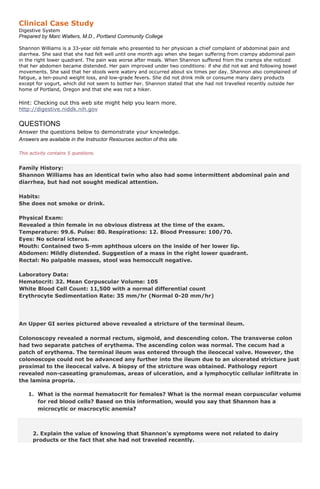
Clinical Case Study Digestive System
- 1. Clinical Case Study Digestive System Prepared by Marc Walters, M.D., Portland Community College Shannon Williams is a 33-year old female who presented to her physician a chief complaint of abdominal pain and diarrhea. She said that she had felt well until one month ago when she began suffering from crampy abdominal pain in the right lower quadrant. The pain was worse after meals. When Shannon suffered from the cramps she noticed that her abdomen became distended. Her pain improved under two conditions: if she did not eat and following bowel movements. She said that her stools were watery and occurred about six times per day. Shannon also complained of fatigue, a ten-pound weight loss, and low-grade fevers. She did not drink milk or consume many dairy products except for yogurt, which did not seem to bother her. Shannon stated that she had not travelled recently outside her home of Portland, Oregon and that she was not a hiker. Hint: Checking out this web site might help you learn more. http://digestive.niddk.nih.gov QUESTIONS Answer the questions below to demonstrate your knowledge. Answers are available in the Instructor Resources section of this site. This activity contains 5 questions. Family History: Shannon Williams has an identical twin who also had some intermittent abdominal pain and diarrhea, but had not sought medical attention. Habits: She does not smoke or drink. Physical Exam: Revealed a thin female in no obvious distress at the time of the exam. Temperature: 99.6. Pulse: 80. Respirations: 12. Blood Pressure: 100/70. Eyes: No scleral icterus. Mouth: Contained two 5-mm aphthous ulcers on the inside of her lower lip. Abdomen: Mildly distended. Suggestion of a mass in the right lower quadrant. Rectal: No palpable masses, stool was hemoccult negative. Laboratory Data: Hematocrit: 32. Mean Corpuscular Volume: 105 White Blood Cell Count: 11,500 with a normal differential count Erythrocyte Sedimentation Rate: 35 mm/hr (Normal 0-20 mm/hr) An Upper GI series pictured above revealed a stricture of the terminal ileum. Colonoscopy revealed a normal rectum, sigmoid, and descending colon. The transverse colon had two separate patches of erythema. The ascending colon was normal. The cecum had a patch of erythema. The terminal ileum was entered through the ileocecal valve. However, the colonoscope could not be advanced any further into the ileum due to an ulcerated stricture just proximal to the ileocecal valve. A biopsy of the stricture was obtained. Pathology report revealed non-caseating granulomas, areas of ulceration, and a lymphocytic cellular infiltrate in the lamina propria. 1. What is the normal hematocrit for females? What is the normal mean corpuscular volume for red blood cells? Based on this information, would you say that Shannon has a microcytic or macrocytic anemia? 2. Explain the value of knowing that Shannon's symptoms were not related to dairy products or the fact that she had not traveled recently.
- 2. 3. Shannon's case has two major clues that implicate a specific vitamin deficiency causing her anemia. What are the clues? 4. What abdominal or pelvic organs might produce right lower quadrant pain? 5. What is the name of the disease that Shannon has in her intestines? Give evidence to support your diagnosis.
